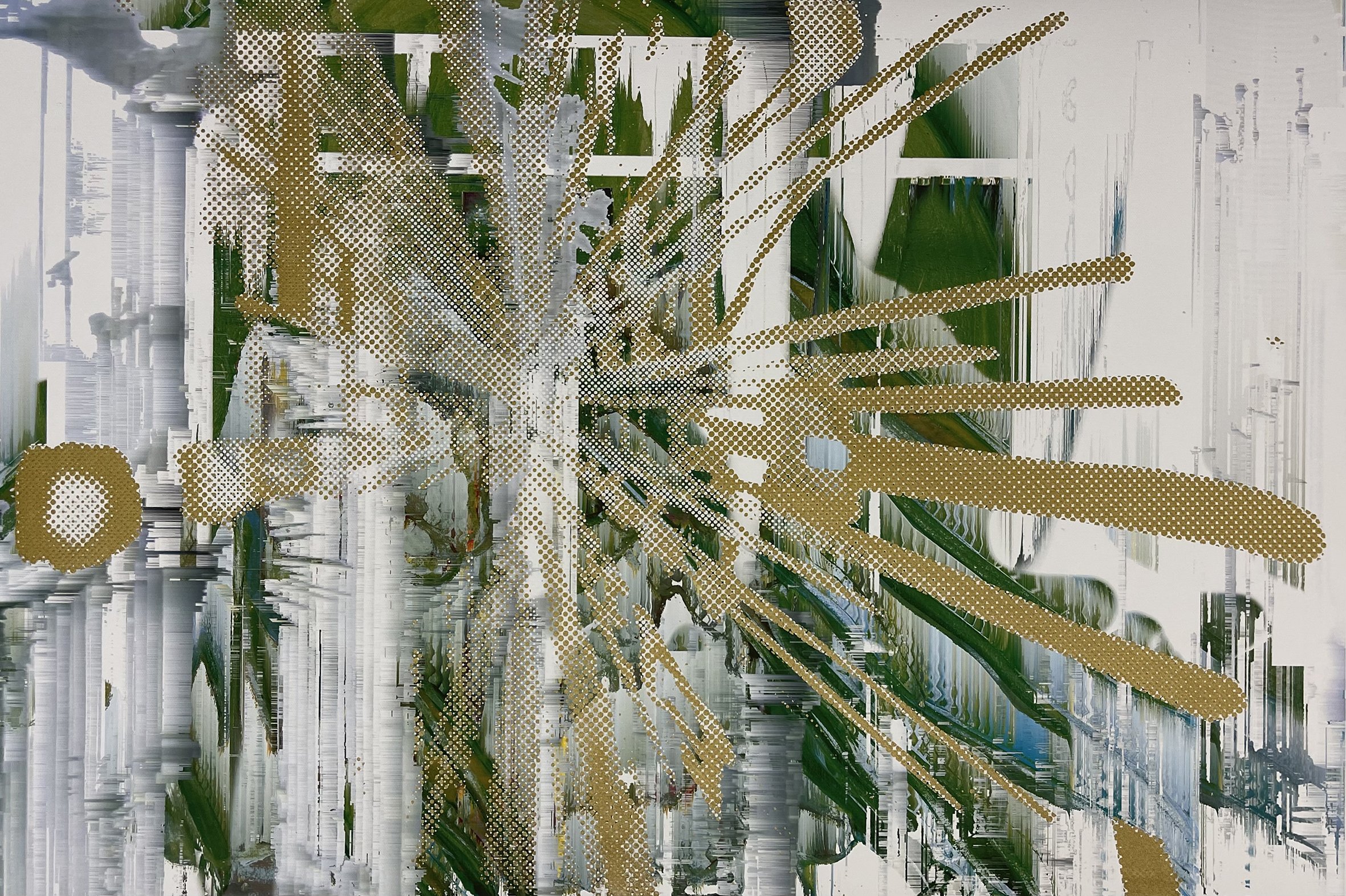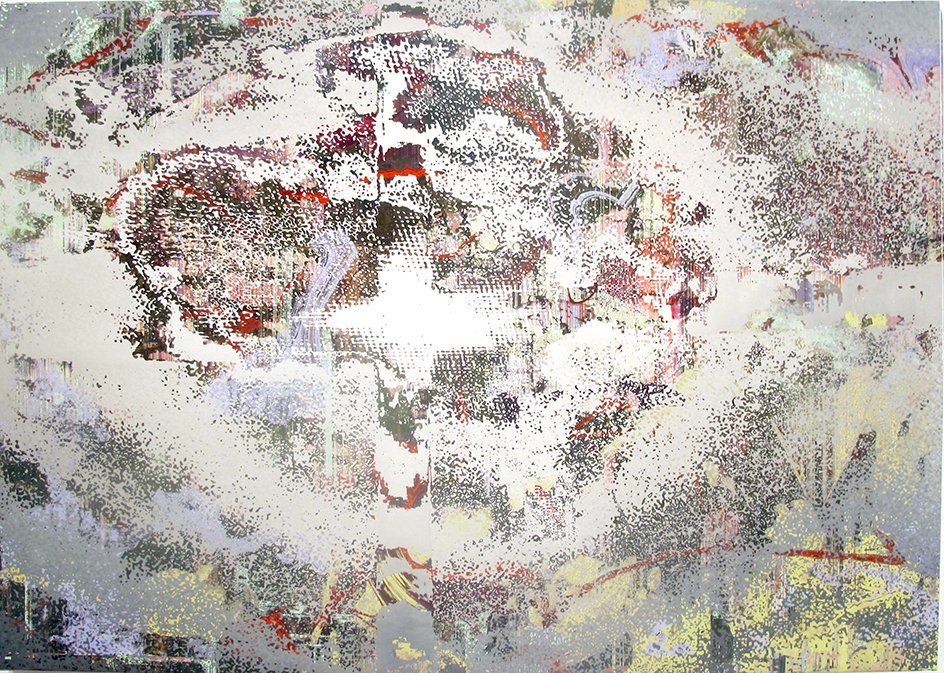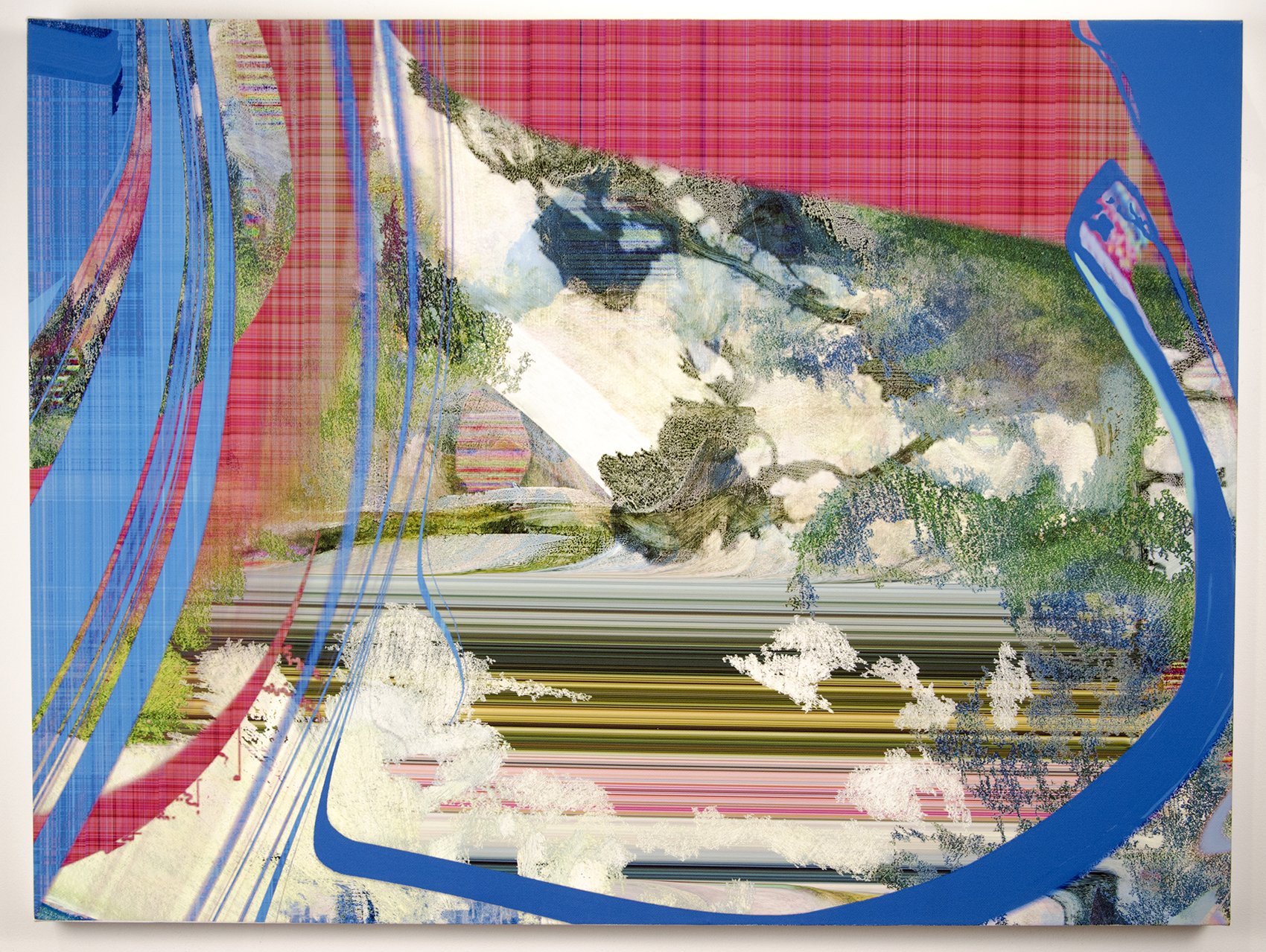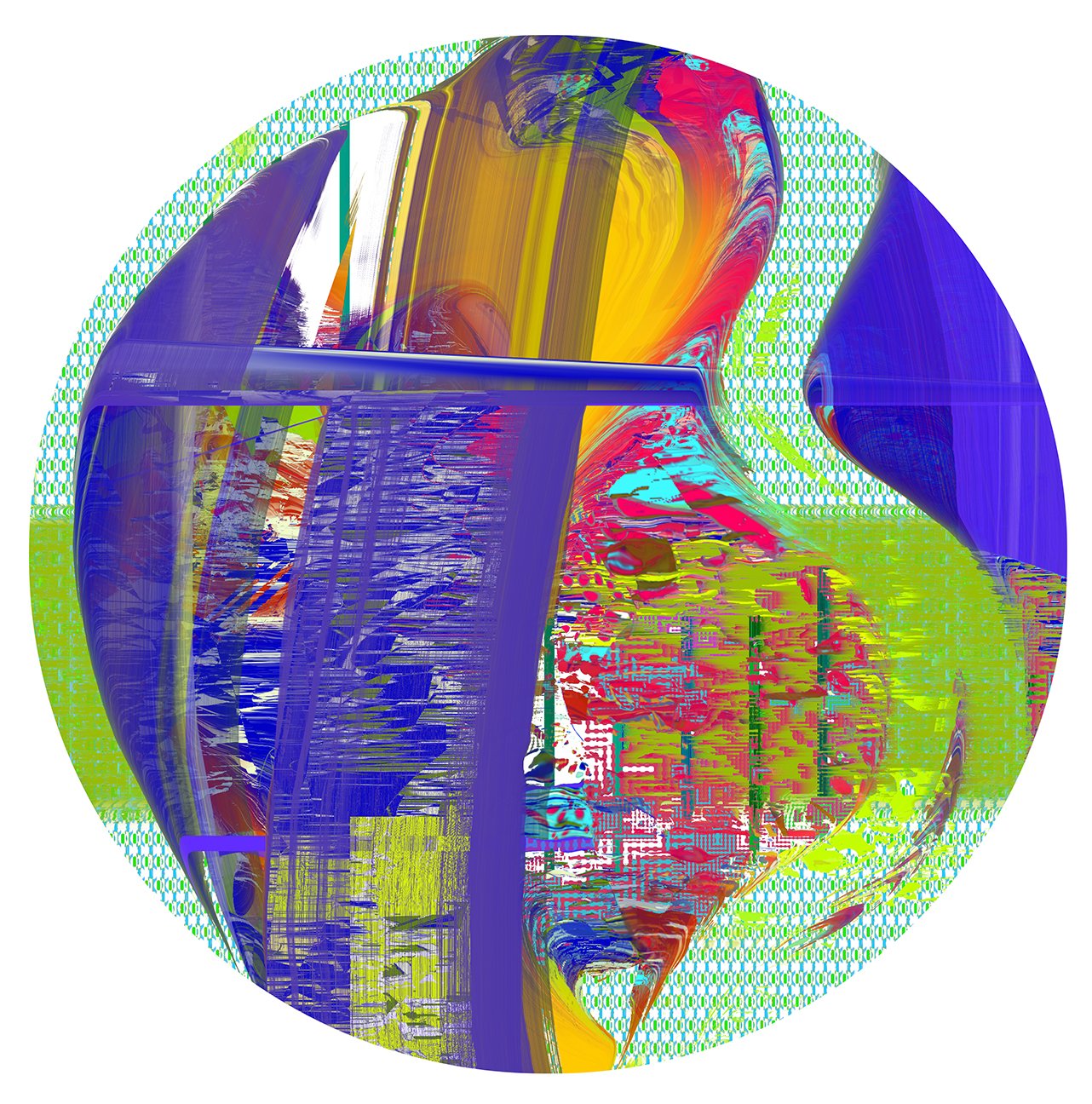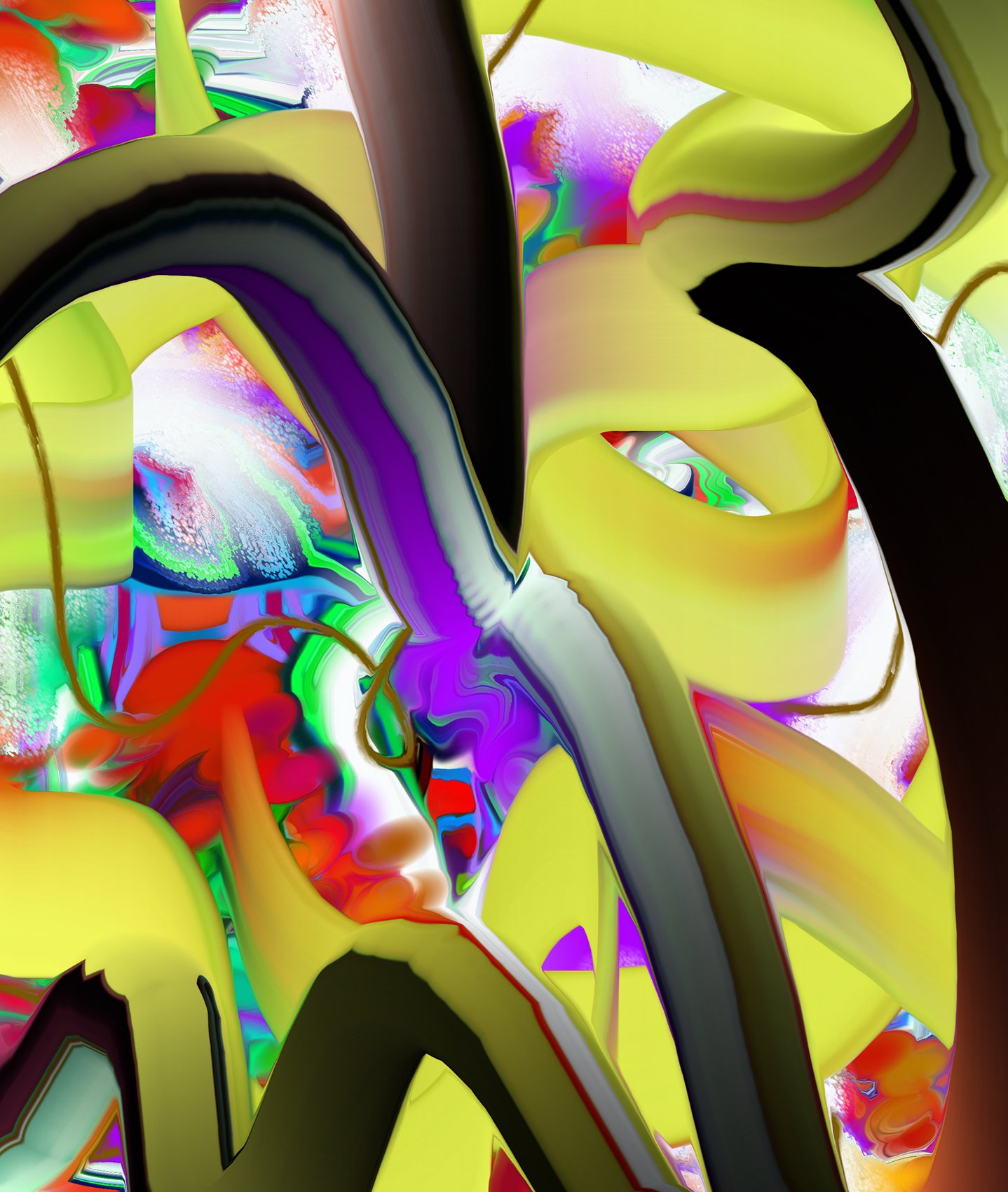VIEWING ROOM: CLAIRE COREY
VIEWSHED
24 x 32 inches, Archival inkjet on canvas, 2009
Live Artist Talk via Zoom
March 15, 2023, 7PM
View Video Recording Below
Slide PDF Here
Selected Press
Art in America
Art Forum
Atlanta Journal-Constitution
In 1995, the digital revolution was still in its infancy, and using digital tools in the art world was not welcome. It was in this environment that Corey lost her studio and began to work digitally on what she believed would be "sketches" for paintings. In time she realized they were works on their own and she gave up her traditional tools and delved into this new material passionately, seeing the possibilities for changing what could be used to make artwork. Utilizing off-the-shelf software meant for advertising, she transformed error patterns and marks into complex paintings. Once the digital revolution in art was accepted, Corey began to incorporate traditional tools back into her work, collaging multiple mediums into the work via directly painting, or scanning various marks and then manipulating them in the computer. She would then repaint, rescan and collage, often then printing out the image and reworking it again with oil, colored pencils, and various mediums. These newly created worked-upon images were, in turn, scanned again. The process repeated itself, democratically incorporating “mistakes” made by the computer, error patterns from memory overload, and marks made by the artist. Every step of the process—the printer’s struggles, the painting process, and the computer errors—were reflected in the final work.
With the prevalence of climate change's effect on our lives, Corey became drawn to physically manifesting change. Found and printed fabric created from computer errors, paper sections cut from earlier works, splats, spray paint, stitching, and brush strokes all come together to make up collages which reflect the hybrid nature of our currently changing heated environment through new and old technologies with great richness, texture, and depth. The final physical forms evoke spills, contaminants, corruption of materials, and disintegration.
Claire Ellen Corey has been the recipient of numerous awards including The New York Foundation for the Arts Fellowship in Computer Arts, The Aldrich Contemporary Art Museum's Trustee's Award for an Emerging Artist, a Pollock-Krasner Foundation grant, and a Marie Walsh Sharpe Art Foundation Space Program grant. Her work has been reviewed in Art in America, Art Forum, and The New York Times among others. She has shown nationally and internationally including solo exhibitions at the Plains Art Museum in North Dakota, Galerie Bugdahn und Kaimer in Düsseldorf, Germany, various galleries in New York City, and many more. Corey lives and works in Brooklyn.
2022
FLOOD
43.5 x 35.75 inches, Inkjet and spray paint on Hahnemühle paper mounted on linen, 2022
“Currently, I have been mining various stages of my early digital work for my new work in my studio. Early printed paperwork that was ruined in a flood became the basis for a new work, Target (2022). This inspired a deep dive into my very early digital files, which have become fodder for new works. It has been extremely exciting, and I have continued working in a mix of abstraction and representation, using printing and painting, spray paint and silk screening onto found fabric, and paper and canvas. I am not concerned with certain material rules, for example, I am happy to add paint to a silkscreened image, or to silkscreen on a painted image, or for that matter, to use any material I can think of that will enhance my compositions.
All of my work is rich with references, and with various forms of painting, printmaking, natural imagery, abstraction, color, and texture. My subject matter has always involved painting and nature: I observe the nature around me, locally, such as in my backyard, where I feed birds and garden. The damage we are doing to our natural world has subtly entered my work over the past decade. Joy is important to me. The joy of creating, and the joy of looking closely. It is my hope that viewers of my work find joy, always and especially, in these dark times.” -Claire Corey
SHELF CLOUD IN GOLD #1
23.75 x 18.5 inches, Inkjet, silkscreen and oil on canvas, 2022
STUDIO VIEW
Putting ink on screen, 2022
Expansion in Materials and in the Picture Plane
FERMENT
44 x 35 inches, Inkjet and silkscreen on Hahnemühle paper, 2017
‘Always interested in playing with the forced rectangular structure of the stretched canvas, I had made shaped canvases in the past, and returned to this idea again in 2013, but pushed it in a different direction. Printing onto paper allowed an image to imply the area of the image could not be contained, expanding past the picture plane. To add to the techniques I utilized, I created and incorporated linocut prints, as well as manipulated my photographs in the computer, and scanned different textures, created or found. All were democratically assimilated into the final images. Furthering the mix of actual and digital materiality within the work, I began painting on the surface of the works in 2015. The viewer is challenged to decipher and discover what was painted, and what was printed, or scanned. They are complex compositions that require careful visual inquiry.
Furthering my experimentation, I created a laser-cut woodblock, a risograph, and inkjet and silkscreen editions of my work with the help of printmakers on-site when I was awarded a residency at Ontario College of Art and Design in2016. I then began thinking more about the material of the canvas itself: Could I sew it? Could I create works using fabric, paper, and stitching, to further push the ideas of what was a painting? I began sewing directly onto the canvas (2019–2021), to continue to push where the image begins and ends. I began using found fabric, used stitching as mark-making, and incorporated inkjet color-proof pieces from older works into these compositions, which gave those works a second life.” - Claire Corey
PURPLE HAZE
25.125 x 35.125 inches, Oil, pastel, inkjet on Hahnemühle paper mounted on linen, 2015/2021
STUDIO VIEW Linocut from Wraith, 2014
STUDIO VIEW Linocut from Wraith, 2014
INSTALLATION VIEW Studio, June 2012
INSTALLATION VIEW Studio, 2013
INSTALLATION VIEW Studio, 2014
Hybrid experimentation
STILL REMAINS
19.625 x 26.5 inches, Archival inkjet on canvas, mounted on aluminum, 2011
FALL INTO WINTER
25 x 31.25 inches, Archival inkjet on canvas 2009
Expanding Digital Work
3P9
48 x 54.75 inches, Inkjet on canvas, 2004
“After a decade of working digitally, I began to experiment with introducing into the final work elements that could not be printed, creating a planal change within the paintings. I started by adding a gloss varnish, creating a "pop" from the rest of the printed matte field of the canvas, and later started adding pearlescent paint. In 2008, I did numerous drawings and paintings inspired by photographs of nature that I had taken, or found online, scanned these images, and incorporated them into my digital compositions, moving them into and out of the digital image, creating cut-and-pasted digital collages. I loved how difficult it became to detect which part of the work was created on the computer and which part was painted, or drawn and scanned. These works became very binary, using both digital and traditional materials, and both abstraction and representation appeared in the compositions.” -Claire Corey
Early Digital Work
UNTITLED PAINTING #1C2
20 x 26 inches, Inkjet on watercolor paper mounted on sintra, 1997
“In 1995, I could no longer afford a studio, and decided to make sketches on my Apple Quadra personal computer with the intention of painting them later. The longer I worked in this way, the more complex the work became, and in time I realized I was as excited about making work digitally as I was with traditional materials—in fact, even more so. I had found a way to create an illusion of oil paint with smears, smudges, and swoops that were and were not similar to oil painting. Creating this work was a stimulating new experience for me: of seeing, of playing with a new tool, and of pushing its boundaries; of turning mistakes and glitches into purposeful trails of detecting and discovering hidden pathways for making art! When my large digital files challenged the computer, making it crash and leaving me with error patterns that erased the image I had been working on, I captured those patterns and manipulated them, and incorporated them, adding the computer's native tongue to the image. This was a wonderful way to transform mistakes into intentional marks. Substantial resistance to the digital work was challenging: many critics did not want to see this new work, and they were not open to a different way of image-making, which they viewed as less physical, less man-made. But for me, these wide-open new avenues for painting excited me, and continue to. These works reflected the increasingly simulated space we were inhabiting, new worlds ripe for exploring.” - Claire Corey











